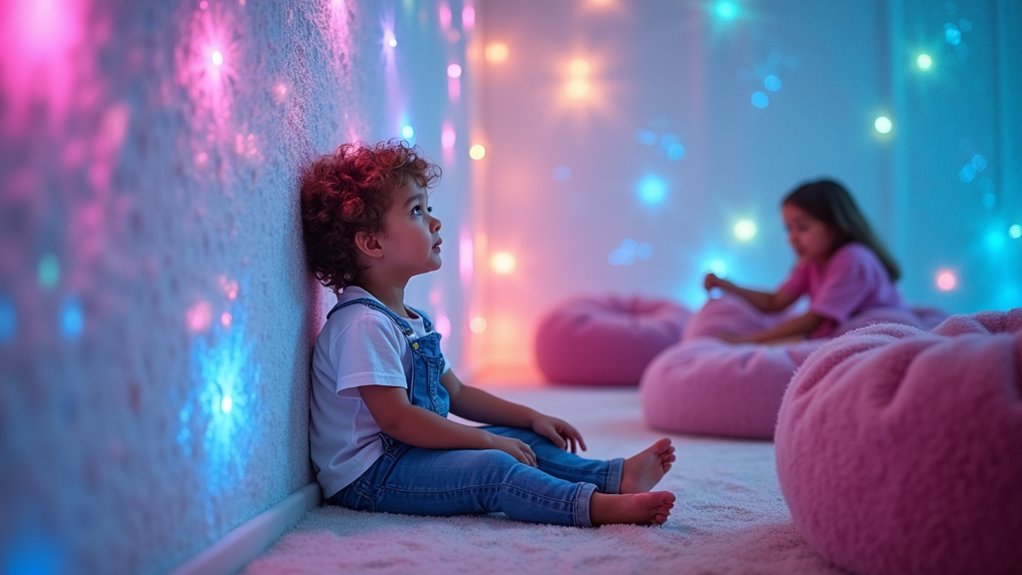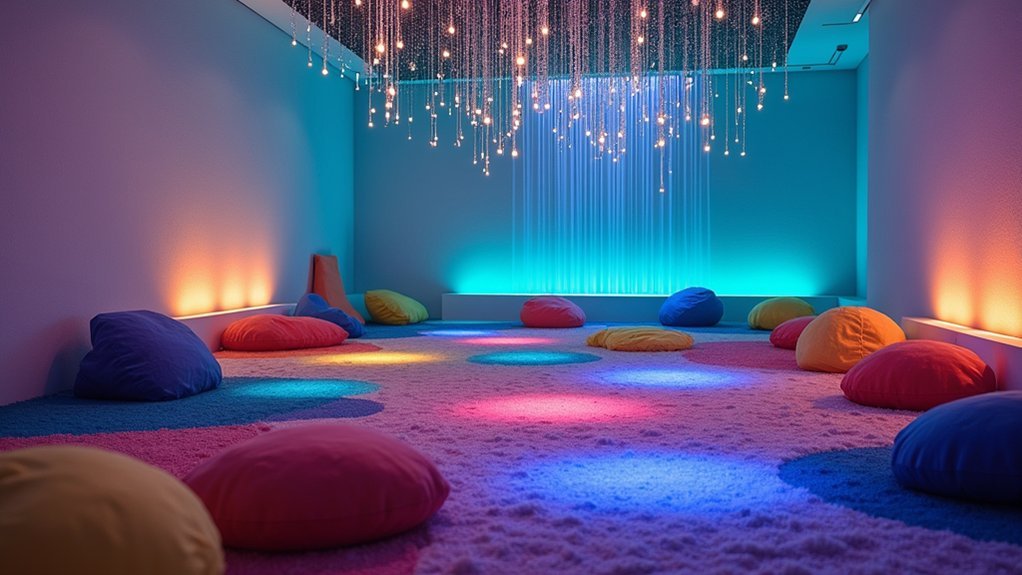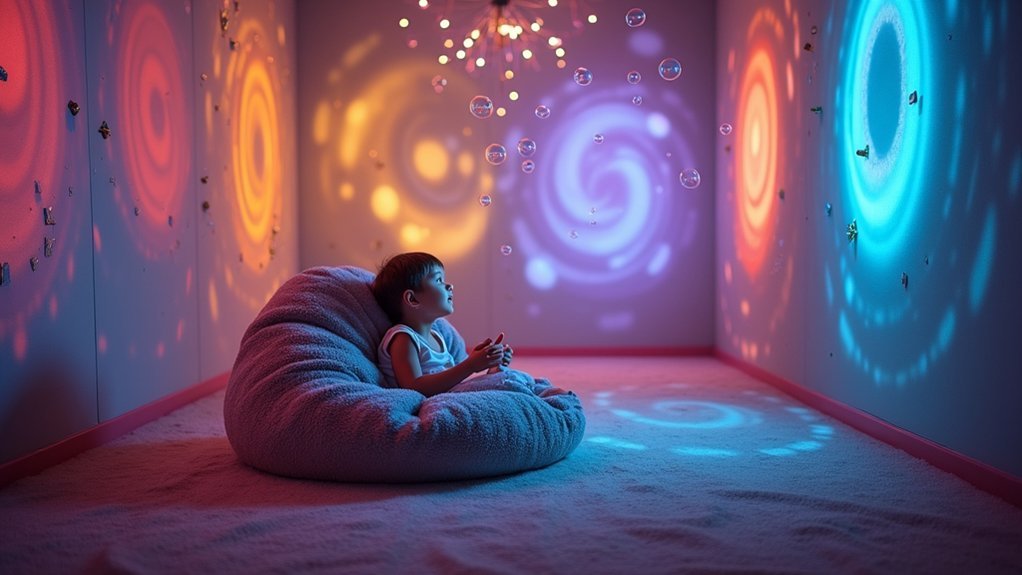Sensory rooms transform disability care by creating controlled environments that reduce anxiety, improve emotional regulation, and enhance communication skills. Research shows they decrease negative behaviors by 50% in individuals with developmental disabilities while boosting independence in daily tasks. You’ll find essential elements like bubble tubes, fiber optic lights, and weighted blankets that stimulate or calm different senses based on individual needs. Discover how these therapeutic spaces revolutionize care through measurable outcomes across various settings.
The Science Behind Sensory Processing and Disability Care

While we often take our sensory systems for granted, individuals with disabilities frequently face unique challenges in processing the world around them. Nearly 1 in 20 children struggle with sensory processing disorder, affecting how they respond to sensory stimuli in their environment.
Your brain processes information through complex networks that can become overwhelmed or underresponsive in those with disabilities. Sensory rooms address this by providing controlled environments that engage multiple sensory pathways, supporting cognitive development and improving attention spans.
Sensory rooms create neurologically-friendly spaces where overwhelmed minds find balance through carefully calibrated environmental stimuli.
Research shows these specialized spaces reduce stress and anxiety by 40% in individuals with autism, facilitating emotional regulation. Additionally, they’ve demonstrated a remarkable 50% decrease in negative behaviors among those with developmental disabilities.
This sensory integration approach transforms disability care by creating environments that work with—not against—unique neurological differences.
Historical Evolution of Sensory Spaces in Therapeutic Settings
The therapeutic use of sensory environments we see today has roots stretching back nearly two centuries. You can trace this journey to 1837 when Friedrich Froebel created the first sensory classroom, emphasizing play’s developmental importance.
Fast forward to the 1970s, when therapists Hulsegge and Verheul advanced sensory rooms as structured spaces supporting sensory learning through diverse experiences.
The rise in Autism Spectrum Disorder diagnoses—now affecting 1 in 44 children—has dramatically increased demand for these spaces.
Today’s sensory rooms have evolved beyond clinical settings into homes, schools, and healthcare facilities. This historical development reflects our deepening understanding of how sensory experiences support emotional regulation for those with neurodevelopmental conditions.
The evolution of these therapeutic settings continues to transform approaches to sensory processing disorders.
Essential Equipment for Creating Effective Sensory Environments

Creating effective sensory environments requires specialized equipment designed to address diverse sensory needs across the spectrum of disabilities.
When you’re designing sensory rooms, focus on tools that promote both engagement and relaxation:
- Bubble tubes provide visual stimulation with soothing, flowing bubbles that can reduce anxiety for those with sensory processing challenges.
- Fiber optic lights create a calming environment with soft, colorful illumination that won’t overwhelm users.
- Interactive wall panels and tactile boards enhance fine motor skills while allowing hands-on exploration of various textures.
- Weighted blankets deliver deep pressure stimulation, helping users feel grounded during moments of sensory overload.
- Adjustable sound machines address auditory needs by allowing individuals to control their acoustic environment effectively.
These equipment choices transform ordinary spaces into therapeutic environments where users can regulate their sensory experiences.
Tactile and Proprioceptive Tools That Enhance Body Awareness
Weighted blankets provide essential deep pressure that helps you regulate your nervous system and develop stronger body awareness through consistent proprioceptive input.
You’ll find that varying textured surfaces, from ribbed mats to bumpy balls, engage different tactile receptors and create neural pathways that improve spatial orientation.
These complementary tools work together in sensory rooms to give you immediate feedback about your body’s position in space, supporting both comfort and developmental progress.
Weighted Blankets and Pressure
When properly integrated into sensory rooms, weighted blankets serve as powerful therapeutic tools that provide deep pressure stimulation for individuals with sensory processing disorders.
You’ll find these blankets particularly effective for improving body awareness and emotional regulation while creating a safe environment for sensory integration.
- Weighted blankets (5-10% of body weight) deliver calming effects that reduce anxiety and sensory overload
- Research demonstrates significant decreases in heart rate and cortisol levels during use
- Proprioceptive feedback enhances spatial orientation and body awareness
- Complementary to other sensory room elements, maximizing therapeutic benefits
- Especially beneficial for individuals on the autism spectrum who experience sensory processing challenges
The pressure from these blankets creates a comforting sensation that mimics being held, promoting relaxation and helping users better regulate their emotions during periods of distress.
Textured Surfaces Matter
Five essential textures should be incorporated into any thorough sensory room design to effectively address proprioceptive needs. You’ll want to include smooth, bumpy, soft, firm, and weighted materials to provide diverse sensory feedback.
These textured surfaces enhance body awareness by engaging touch receptors that help individuals develop vital proprioceptive skills.
When you introduce tactile tools like sensory balls and fidget toys, you’re supporting emotional regulation as users learn to process varying sensory inputs. During overwhelming moments, these calming tactile experiences can meaningfully reduce anxiety by grounding the individual.
For those with sensory processing challenges, proprioceptive tools delivering deep pressure input—like weighted blankets—improve spatial orientation and movement control.
This extensive approach to textures creates an environment where individuals can safely explore sensations while developing the body awareness necessary for daily functioning.
Visual Elements and Lighting Solutions for Sensory Regulation

When creating a sensory room, you’ll find that lighting options greatly impact how individuals respond to the environment.
You can install dimmable LED lights that allow for brightness adjustment based on specific sensory needs, while bubble tubes and fiber optic lights provide engaging visual stimulation without overwhelming users.
The colors you choose matter too—blues and greens typically promote calmness, while warmer tones like yellow and orange can energize and encourage social interaction.
Lighting Options Matter
Every aspect of lighting in a sensory room can greatly impact how individuals with sensory processing difficulties experience their environment. The right lighting options create environments where users can better regulate their emotions and find calm amidst sensory challenges.
- Soft, dimmable lights allow for customization based on individual sensitivity levels.
- Color-changing LEDs provide therapeutic benefits through intentional color selection—blue for calming effects, warmer tones for comfort.
- Bubble tubes and fiber optic elements create engaging visual stimulation that promotes both focus and relaxation.
- Adjustable lighting improves attention span and helps users connect with their surroundings.
- Natural light incorporation enhances mood and overall well-being, complementing artificial lighting solutions.
You’ll find that thoughtfully designed sensory rooms with varied lighting options greatly reduce anxiety while supporting emotional regulation for those with sensory processing difficulties.
Color Psychology Benefits
Color psychology represents a powerful dimension of sensory room design that works hand-in-hand with the lighting options previously discussed.
You’ll find that soft blues and greens create a calming environment, helping reduce anxiety and enhance relaxation for individuals with sensory processing challenges.
When you incorporate dimmable lighting solutions, you’re enabling users to customize brightness levels to their comfort, directly supporting emotional regulation.
Visual elements like fiber optic lights and bubble tubes don’t just provide sensory stimulation—they transform the space into an inviting, engaging atmosphere.
LED mood lights can create immersive experiences that capture attention and encourage exploration.
Research confirms that blue tones specifically promote a tranquil atmosphere, which is why they’re frequently chosen for sensory rooms.
These thoughtful color choices, combined with appropriate lighting, create spaces where sensory regulation becomes more intuitive and accessible.
Auditory Components That Soothe and Stimulate Appropriately
Because sound profoundly affects neurological responses, auditory elements form a critical component of effective sensory rooms. When you incorporate adjustable auditory stimuli, you’re creating a calming atmosphere that helps individuals with sensory processing difficulties regulate their emotions during overwhelming situations.
- Sound systems and white-noise machines reduce external distractions.
- Nature sounds and gentle music lower anxiety levels, particularly for those with autism.
- Interactive auditory elements like musical instruments encourage engagement and communication.
- Personalized audio settings allow users to tailor their environment to individual preferences.
- Properly selected auditory components improve focus and attention for those with learning disabilities.
These soothing sounds not only create a peaceful environment but also serve therapeutic purposes, helping individuals develop cognitive skills while providing comfort when they need it most.
Vestibular Equipment for Balance and Movement Therapy
While auditory elements address sensory needs through sound, the physical body requires equal attention in thorough sensory environments. Vestibular equipment offers essential therapeutic benefits for those with sensory processing challenges, enhancing balance and movement capabilities. You’ll find that swings, balance boards, and rocking chairs greatly improve proprioception and emotional regulation.
| Equipment Type | Benefits |
|---|---|
| Swings | Enhances body control and reduces anxiety |
| Balance Boards | Improves coordination and spatial awareness |
| Rocking Chairs | Promotes calming and self-regulation |
| Therapy Balls | Strengthens core muscles and stability |
Creating Multi-Sensory Experiences for Comprehensive Development
When you integrate tactile exploration activities into sensory rooms, you’re helping participants develop fine motor skills while simultaneously building neural pathways essential for sensory integration.
Visual stimulation techniques, such as color-changing fiber optic displays and interactive projection systems, can capture attention and improve focus for users with varying processing abilities.
Incorporating auditory processing elements like sound walls or rhythm instruments will strengthen listening skills and provide opportunities for self-expression that complement the tactile and visual experiences.
Tactile Exploration Benefits
Through thoughtfully designed tactile elements, sensory rooms provide exceptional developmental opportunities for individuals with disabilities. When you engage with various tactile materials, you’re not just playing—you’re developing essential life skills. Tactile exploration helps improve sensory processing abilities, particularly beneficial for those with autism who often struggle with environmental stimuli.
- Enhances fine motor skills through gripping and manipulating different textures
- Strengthens neural pathways that foster cognitive development and problem-solving
- Boosts self-confidence and independence through creative exploration
- Reduces anxiety and stress levels during sensory experiences
- Helps regulate emotions by providing calming tactile feedback
These multi-sensory experiences aren’t just enjoyable—they’re therapeutic. By incorporating diverse tactile materials like textured panels and sensory bins, you’ll create spaces that transform daily challenges into opportunities for growth and well-being.
Visual Stimulation Techniques
Effective visual elements transform ordinary sensory rooms into powerful therapeutic environments for people with disabilities. By incorporating visual stimulation techniques like bubble tubes, fiber optic lights, and projection systems, you’ll create spaces that reduce anxiety and promote relaxation for individuals with sensory processing challenges.
| Visual Element | Benefits | Best For |
|---|---|---|
| Adjustable lighting | Customized experience, reduced overwhelm | Sensory sensitivity |
| Interactive wall boards | Tactile exploration, cognitive development | Motor skill building |
| Calming visuals | Stress reduction, emotional regulation | Anxiety management |
Research shows these environments greatly improve attention spans while reducing negative behaviors in individuals with autism. When you combine visual elements with tactile exploration opportunities, you’ll create thorough sensory experiences that support overall well-being and enhance social interactions for those in your care.
Auditory Processing Enhancement
Sound plays an essential role in creating effective sensory environments that support individuals with processing disorders. By introducing auditory elements in sensory rooms, you’ll help users with sensory processing difficulties reduce anxiety levels while improving focus and attention span.
- Calming music and nature sounds create controlled auditory environments that enhance understanding of environmental stimuli.
- Interactive sound equipment encourages communication and social interaction through shared experiences.
- Multi-sensory experiences combining auditory with visual and tactile elements facilitate cognitive development.
- Regular exposure to varied sound activities improves emotional regulation, helping manage stress and sensory overload.
- Auditory processing activities in sensory rooms promote problem-solving skills and creative thinking, making learning more engaging.
These auditory components create extensive sensory experiences that transform how individuals interact with their world, building fundamental skills for daily living.
Measuring Outcomes and Progress Through Sensory Integration
When professionals implement sensory integration therapy in dedicated sensory rooms, they can effectively track measurable improvements across multiple domains of functioning. You’ll see concrete evidence of progress as individuals with autism spectrum disorders and sensory processing challenges develop essential skills.
| Domain | Typical Improvement | Timeframe |
|---|---|---|
| Emotional Regulation | 40% reduction in overstimulation | 2-3 months |
| Communication Skills | 30% increase in verbal interactions | 4-6 weeks |
| Negative Behaviors | 60% decrease in aggression/anxiety | 8-12 weeks |
| Daily Living Skills | 25% increase in independent tasks | 3-4 months |
These statistics aren’t just numbers—they represent real transformation. As you monitor progress through behavioral assessments, you’ll witness individuals gaining independence and confidence, enabling meaningful participation in educational and community settings.
Staff Training and Implementation Strategies for Maximum Benefit
To maximize the therapeutic benefits of sensory rooms, thorough staff training must form the foundation of your implementation strategy.
When your team understands sensory processing challenges, they’ll confidently support users’ unique sensory needs through targeted intervention techniques.
Effective training programs should include:
- Practical scenarios with role-playing exercises to identify sensory overload triggers
- Detailed education on sensory equipment functions and therapeutic applications
- Regular professional development to keep current with sensory integration research
- Clear protocols for creating tailored sensory experiences for different users
- Consistent implementation strategies for maintaining a safe environment
Designing Inclusive Spaces for Various Disability Needs
Once staff are properly trained, attention must shift to the physical environment itself.
When designing sensory rooms, you’ll need to prioritize an inclusive atmosphere through soft, calming colors and sound-absorbing materials that accommodate diverse sensitivities.
Your space should feature interactive equipment like bubble tubes and wall panels that can be adjusted to meet individual needs—calming elements for those with autism or stimulating features for people with sensory processing disorders.
Ascertain emotional regulation is supported through tools like weighted blankets in a safe, controlled setting.
Don’t overlook accessibility—make your room navigable for users with physical disabilities by incorporating wheelchair access and appropriate seating.
This thoughtful approach creates a therapeutic experience that encourages communication, social interaction, and wellbeing for everyone who enters the space.
Cost-Effective Solutions for Homes, Schools, and Care Facilities
Although sensory rooms provide valuable benefits, they needn’t come with hefty price tags. You can create cost-effective solutions that meet sensory needs while staying within budget constraints.
- Transform existing spaces in schools using affordable items that promote student engagement without extensive renovations.
- Utilize simple home modifications like tents, weighted blankets, and sensory toys to create effective environments.
- Seek guidance from organizations like St Jude’s Disability Services to navigate NDIS funding options.
- Implement sensory rooms in care facilities to improve emotional regulation, potentially reducing long-term care expenses.
- Create DIY sensory spaces that address specific needs without purchasing expensive pre-made kits.
Case Studies: Real-World Transformations Through Sensory Integration
The impact of sensory rooms extends far beyond theory, as demonstrated by numerous success stories across various settings. You’ll find that sensory rooms provide measurable benefits for individuals with sensory processing challenges. A school implementation reduced behavioral incidents by 40% among students with autism, while healthcare facilities saw a 25% increase in patient compliance during medical visits.
| Setting | Impact | Timeframe |
|---|---|---|
| School | 40% reduction in behavioral incidents | Academic year |
| Healthcare | 25% increase in patient compliance | 3 months |
| Home | 30% decrease in meltdowns | 6 months |
| Therapy Center | 50% improvement in communication | 12 weeks |
| Various Settings | 90% user satisfaction with calming environment | Ongoing |
These results confirm that properly designed sensory integration programs create a soothing atmosphere where users can improve their sensory processing capabilities and overall well-being.
Frequently Asked Questions
How Do Sensory Rooms Help Special Needs?
Sensory rooms help you with regulation by providing tailored stimuli for your specific needs. You’ll experience reduced anxiety, improved focus, and better communication skills while engaging with equipment that enhances your motor development and coping abilities.
What Are the Benefits of a Sensory Integration Room?
Sensory integration rooms benefit you by reducing anxiety, improving focus, and building coping skills. You’ll experience better emotional regulation, enhanced cognitive development, and reduced negative behaviors through controlled sensory experiences tailored to your specific needs.
Why Do Autistic People Like Sensory Rooms?
You’ll find sensory rooms appealing because they let you control your sensory environment, reduce overwhelm, and explore stimuli at your own pace. They’re safe spaces where you can self-regulate and feel comfortable.
What Is the Goal of a Sensory Room?
The goal of a sensory room is to provide you with a safe environment where you’ll explore sensory experiences, develop coping skills, improve emotional regulation, and reduce anxiety through controlled, adjustable sensory stimuli.
In Summary
You’ve now seen how sensory rooms revolutionize disability care through evidence-based design. By incorporating the right equipment and training staff properly, you’ll create spaces that truly respond to diverse needs. Whether you’re working with limited resources or designing all-encompassing environments, you’re not just building rooms—you’re creating transformative experiences that enhance regulation, independence, and quality of life for those in your care.





Leave a Reply